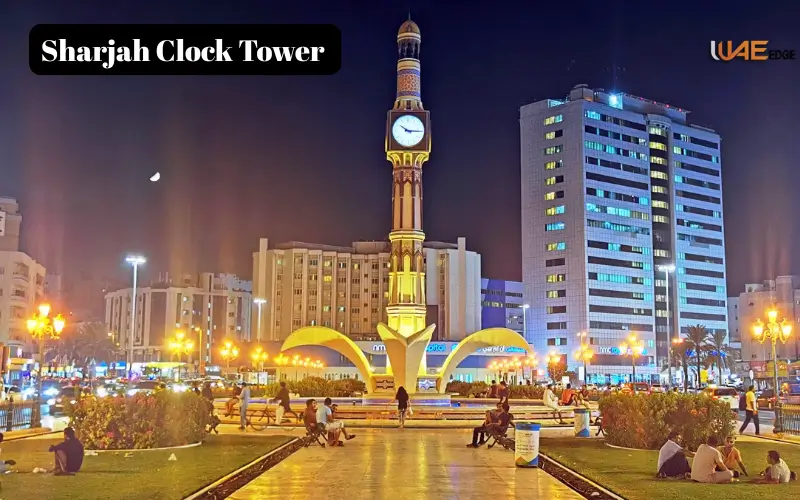Introduction
As the cultural center of the United Arab Emirates, Sharjah is a city that is a perfect combination of modernity and tradition. The Sharjah Clock Tower is one of many architectural monuments dedicated to the continuing growth and spirit of ambition of the city. The tower stands at the crossroads of Khalid Lagoon and Al Hisn Road as more than a functional timepiece; it symbolizes the transformation of Sharjah from a small trading hub to a lively metropolitan city.
Historical Background
Origins
The Sharjah Clock Tower was built in 1966, and at the time, the UAE was developing and urbanizing a lot faster. At this period of time, the emirate was changing its old methods of settlements to contemporary architectural designs. The tower was built as both a useful time-keeping technique and a representation of progress and civic pride.
Construction
It has been built in a combination of modern construction and traditional Islamic architecture, with a focus on both lifecycle and beauty. The tower was quickly becoming a big monument and symbolized the ambitions of the city and its embrace of modernization.
Symbol of Progress
The tower became a symbol of modernization in Sharjah. When the UAE started building infrastructure, education, and urban areas in the 1960s, the Clock Tower symbolized the fusion of tradition and modern vision.
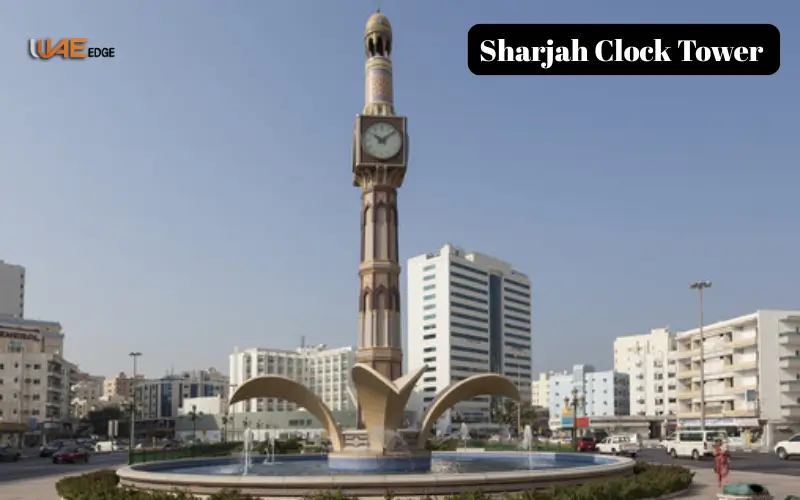
Accessibility and Transportation
| Mode | Details |
| By Car | Al Wahda Street & King Faisal Street |
| Parking | Available near the tower |
| By Bus | Routes 15, 22, 88, 99 |
| Metro Access | Al Qasba Metro (Dubai) → taxi/bus to Sharjah |
| Pedestrian Access | Safe walking paths around the tower & park |
Architectural Features
Overall Design
The Sharjah Clock Tower is a perfect blend of Islamic architectural themes with contemporary structural engineering. It rises 163 meters above the ground, thus catching the eye of just about every area in the city. The tower is circular at the bottom with a gradual change to square as one goes up until it reaches its zenith as a pointed spire which extends to the sky.
Clock Faces
The four large clock faces that are 43 meters on each side of the tower are one of the biggest highlights of the site. These are some of the largest clocks in the world and can be seen far away, and are more than just a convenient timepiece, but also a symbolic part of the Sharjah skyline.
The clock faces can be lit up with highly developed lighting systems at night, forming an enthralling sight. After the sun sets, the nighttime lights lure photographers, tourists, and locals to the tower and make it a shining focal point in the city.
Observation Deck
The observation deck is located near the top of the tower, and it gives the visitor an overview of Sharjah. It is possible to observe, from this point of view:
- Khalid Lagoon shines with its waters.
- The busy streets and the residential areas of the city.
- It is close to the Sharjah Art Museum and the Al Majaz Waterfront.
One of the most popular places visited by photography fans and tourists is the observation deck, where they can see the city from a new angle.
Park and Landscaping
A well-landscaped park is the complement of the tower. This area features:
- The grass and bushes are well taken care of.
- Rambling tracks and exercise tracks.
- Seating benches and shaded relaxation seats.
- Secured and walkable roads.
The park helps to change the neighborhood around the tower into a social and recreation centre, which is best suited to families, tourists, and residents who want to have fun in a peaceful setting.
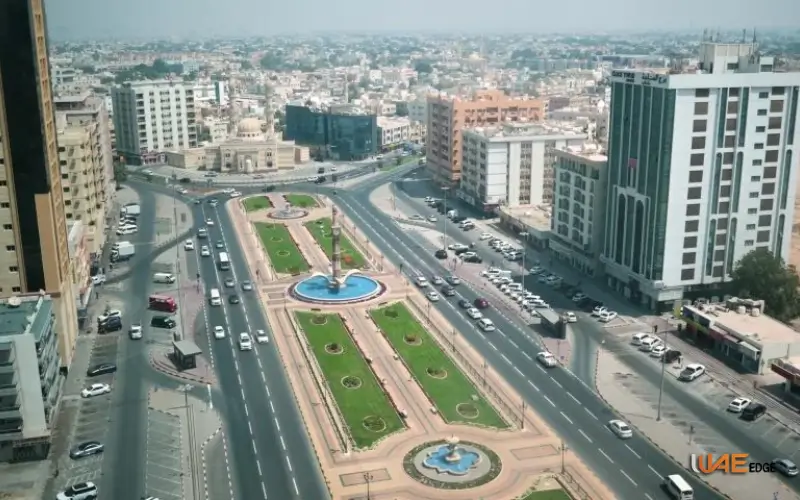
Social and Cultural Meaning
Community Hub
The Sharjah Clock Tower environs have gradually grown into a community socialization center. Visitors and locals come to the park and other streets within the locality to perform various activities, which include:
- Morning and evening walks
- Fitness and jogging.
- Family picnics and recreation.
- Cultural and social events
The tower makes this look like one community and makes the tower the hub of the collective life in Sharjah.
Nearby Attractions
The tower has been placed in a convenient position in relation to other cultural, recreational, and commercial landmarks. That is why it is a good place to start visiting the city. Key attractions include:
Sharjah Art Museum
It is one of the best tourist sites where art lovers can get a diverse collection of classical and contemporary art of the UAE and the Arab region in general.
Central Souk
A traditional trading centre where various types of goods are sold, including textiles, spices, jewelry, and souvenirs. It is a living example of the trading history of Sharjah.
Al Majaz Waterfront
A lively area near restaurants, cafes, recreation centers, and a musical fountain. It suits perfectly well when one is traveling with the family, is out wandering in the evenings, and is otherwise free.
The geographical location of the tower implies that the tourist does not have to travel long distances to reach cultural, commercial, and recreational places.
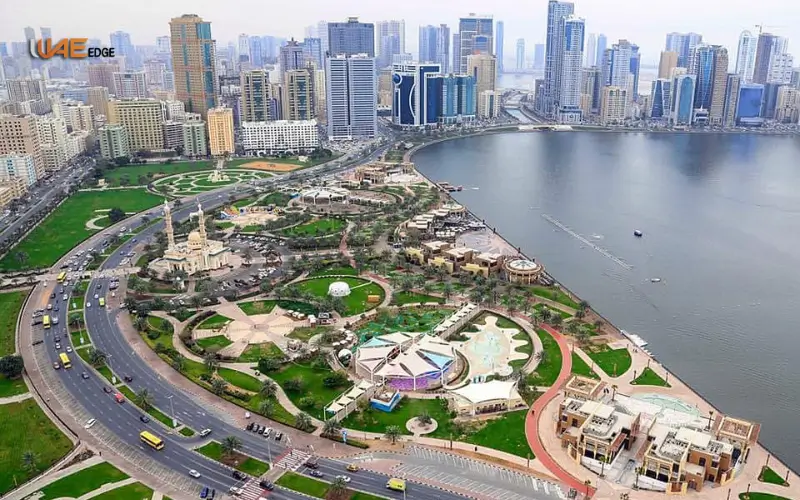
Travel & Cost Guide
| Category | Details |
| Entry Fee | Free (park & exterior); some areas may charge small fee |
| Parking Fee | Free and paid Paris King available, depending on the area |
| Taxi Cost (from Dubai) | AED 40–60 (approx. 20–30 mins depending on traffic) |
| Public Bus Cost | AED 10–15 from Dubai to Sharjah |
| Budget for Visit | Around AED 50–100 if including meals, transport & souvenirs |
Visitor Experience
Sightseeing Opportunities
The observation deck has wonderful panoramic views of the city, the lagoon, and the surrounding cultural attractions. Tourists may enjoy the Sharjah skyline in the day or have a magical view of the illuminated tower at night.
Recreational Activities
The landscaped park offers a lot of recreational activities:
- Strolling or running on the pavements.
- Hiking with family and friends.
- Especially photography at sunset or at night.
- Going to small cultural or neighborhood events.
- Educational and Cultural Value
Educational and Cultural Value
The tower is also informative as it demonstrates the combination of modern design with Islamic architecture. It has been used as a reference in urban planning and architecture to show how cultural heritage may be incorporated into new buildings.
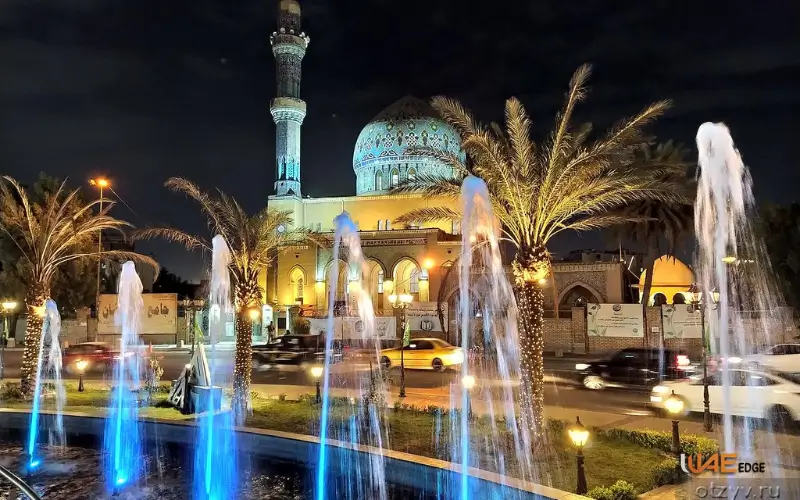
Practical Tips for Visitors
Best Time to Visit
- Evening: best when it is a time to watch the light clock face and the lights of the city.
- Daytime: Daytime is good for exploring the park and the observation deck.
Visitor Guidelines
- Carry water and sunscreen, especially during the summer months.
- Follow the local culture and save the park.
- Check the bus and metro times, provided there is public transport
Conclusion
The Sharjah Clock Tower is not just a landmark; it is also a representation of the city, its history, culture, and ambition. Its amazing architecture, central position, and the recreational area around it make it a place that should be visited by both tourists and locals.
Sharjah Clock Tower is not merely a place to come and see a structure; it is a place to come and feel the heart and soul of Sharjah, where the fusion of tradition and modernity has reached its ideal.
Must Visit: Abu Dhabi Travel Hub Umm Yifenah Island
Al Hudaiba Awards Hub in Dubai What to Expect Before You Go
Sharjah Clock Tower- FAQs.
1. Where is the Sharjah Clock Tower?
It is at the crossing point of Khalid Lagoon and Al Hisn Roads, Sharjah, UAE.
2. What is the height of the Sharjah Clock Tower?
The tower is 163 meters high, and it is one of the tallest buildings in Sharjah.
3. What was the date of construction of the Sharjah Clock Tower?
It was built during the modernization stage in Sharjah in 1966.
4. Does it have a clock face around all sides of the tower?
There are actually four giant clock faces, 43 meters in diameter, on the tower, which can be seen miles away.
5. Is there an observation deck that visitors can access?
Yes, there does exist an observation deck which provides panoramic views of Sharjah city and Khalid Lagoon. It may have a small entry fee, depending on the area.
6. When is the Sharjah Clock Tower most worth visiting?
Evenings are the best time to experience the nighttime light, as afternoons are the best time to sightsee and visit the park.



